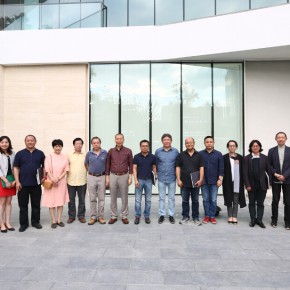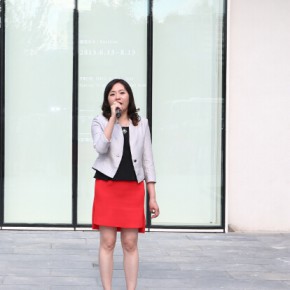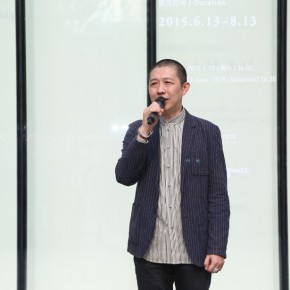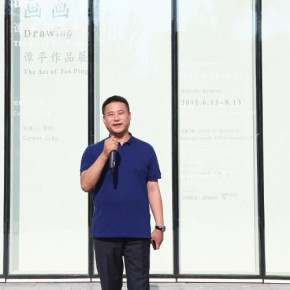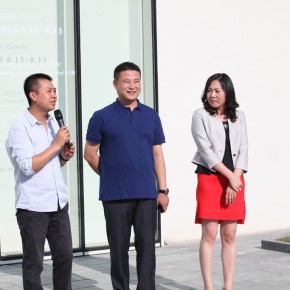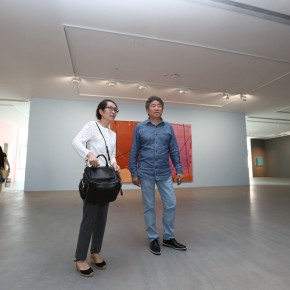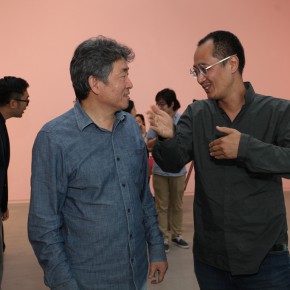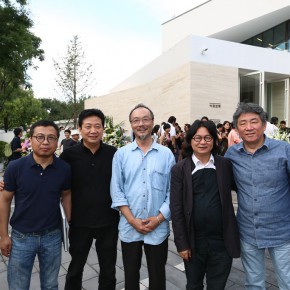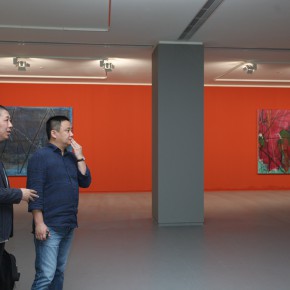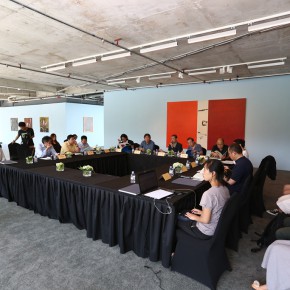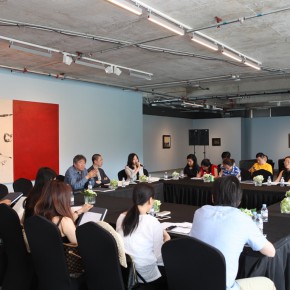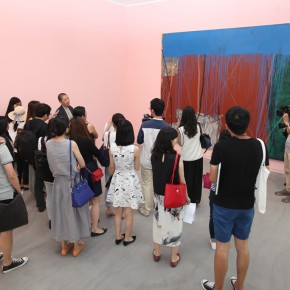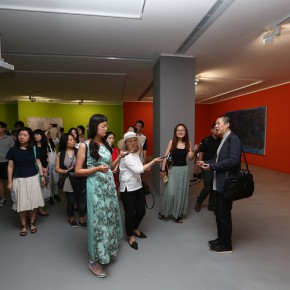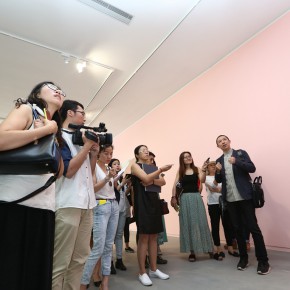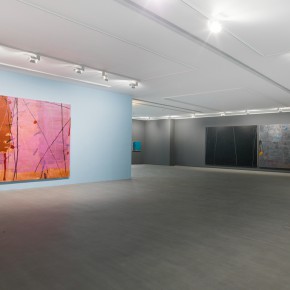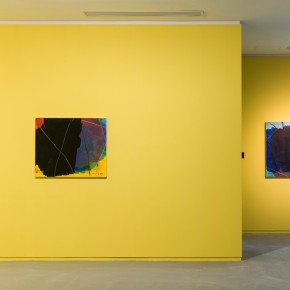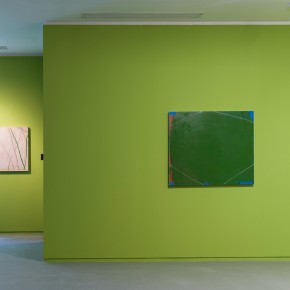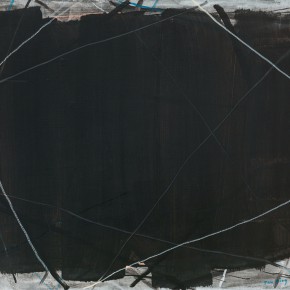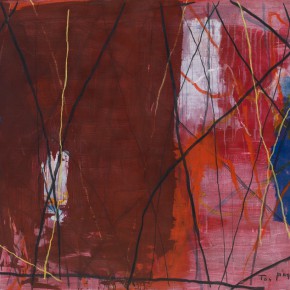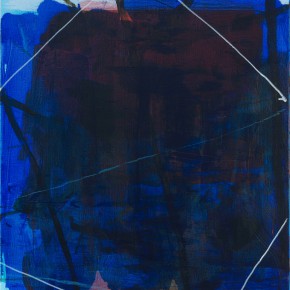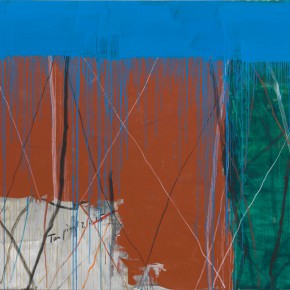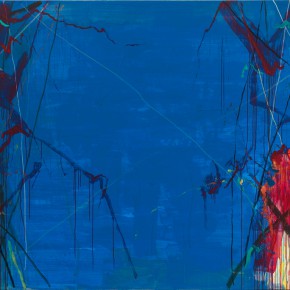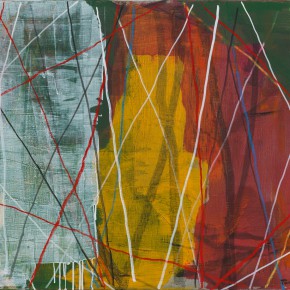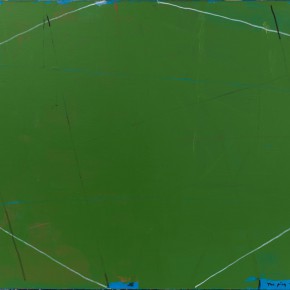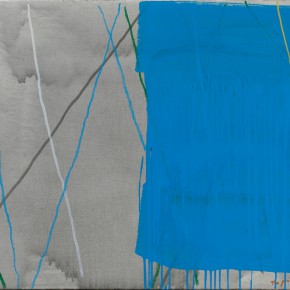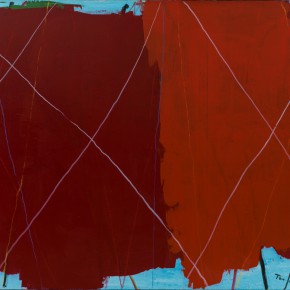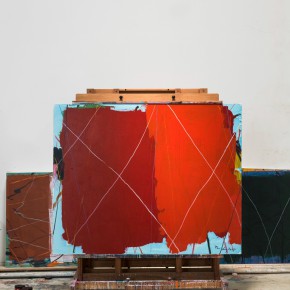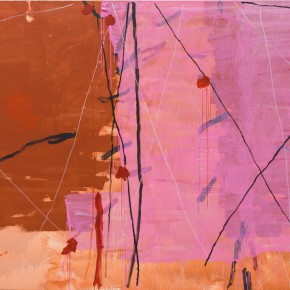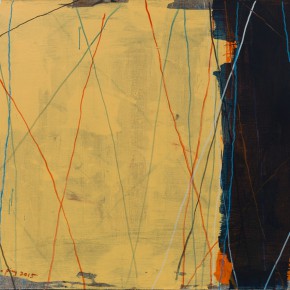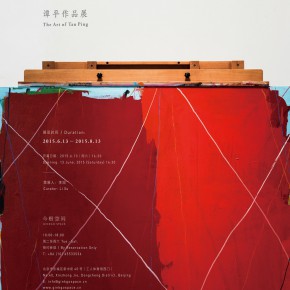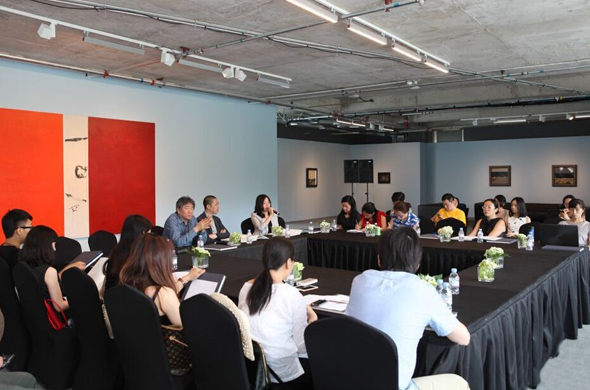
Date: June 13th ,2015
Venue: Gingko Space
Li Xu: As the curator of the exhibition Drawing: The Art of Tan Ping, I feel very honored today to be able to invite the experts, scholars and teachers. Here we will discuss two topics: one is what the context of abstract art in contemporary China is, the other one is a discussion on Tan Ping’s latest creation in this exhibition. Now, I will first give the floor to Mr. Peng Feng.
Peng Feng: I have two questions. The first one is currently Tan Ping’s creation has reached the fourth stage, so what will the fifth one be? Should we enter a discussion on what he is going to draw? The second is what motivation drove him to start drawing on canvas?
In the review article Pricking & Consolation, I mentioned Tan Ping’s motivation for the circular lines in his works, then why he changed them to straight ones? If we find this motivation, it will not be a pure “drawing”, it might have a connection with the psychological state of Chinese contemporary artists and intellectuals. In other words, Tan Ping’s abstract art is not a pure formal work anymore, but has a connection with the intellectual’s psychological feelings in the rapid changing Chinese society.
From “Drawing it”, “Drawing me”, “I draw” to the fourth stage “Drawing”, “Drawing” in Chinese is “Huahuaer”, is it a verb-object structure or a subject-predicate structure? Does that mean I want to draw a drawing, or draw my own drawing? Richter in a video once said: I never "paint a painting”, it is the "painting" itself that paints, not "me". Perhaps when an artist reaches a certain stage, it is the painting itself that forced the artist to paint, his motivation is to paint a painting. Tan Ping uses the repeated coverings to eliminate the intense subjective space. He has been trying to let the “painting” itself talk through continuous covering and self-subversion, to let the painting paint itself talk and paint. It is the ultimate way of painting I can imagine, so I will continue to wait to see how Tan Ping’s creation will develop.
Li Xu: A viewpoint I mentioned in the review article, returning to the depth of the drawing, looking back to the original point –when we learned drawing at the very beginning, what is our expectation? How could we identify our place in space and history through the form of drawing, “Drawing” eventually becomes a very simple word.
Another way of interpretation can be understood as "painting itself" making a self-statement. When Jesus made his first speech to his followers, St. Paul and St. Mark next to him asked what he was going to speak about to his followers, Jesus answered “I just need to open my mouth, God will speak for me.” In most cases, abstract art will speak for itself, when you listen to its statement, you would hear an internal echo from art.
Shang Yang: Tan Ping and I got to know each other when he was in his third year of university, I went to his dormitory and his studio to see his works, all of his practice works impressed and surprised me. At that time I was thinking how a junior majoring in printmaking could have such great color achievement, or it can be called color education, and furthermore how could he have such an unconventional and unrestraint thinking? It was 1983, the very beginning of China’s opening and reform policy, there was not much artistic information in domestic art but an art student could express so much farsighted stuff in his works. I was touched by one of his drawing called Smoke from a Kitchen Chimney, it is quite a small work, an ordinary view of the entrance of a village, a few birds standing on the wire but it completely expresses the very sensitive and deep mind of the artist. Since then, I have believied that Tan Ping would be a great artist one day.
In 1994, when Tan Ping returned to CAFA from Germany, he lived in a two-story building with Teng Fei. The floor of his room was covered with small pictures of symbols. At that time, I already had in-depth communication with him, and I can feel his unorthodox and innovative understanding in abstract art. Later he started to establish the Designing School of CAFA, I think also due to his creativity in designing education, his painting path was able to expand.
There is an inherent connection between Tan Ping’s abstract art today and the figurative paintings he created in his third year of university and the exhibition “Drawing” is just a reflection of his diligent practice and his gradual progress as an artist. He has never abandoned the ontology, every artist who understands and is obsessed with the ontology of painting, can find surprises and a philosophical thinking beyond the painting itself in his work. When I see Tan Ping’s latest works today, I feel it is not easy for him, because when he unloaded the burden, painting becomes a release to him.
Yi Ying: Tan Ping’s “Covering” Series marked a watershed in his artistic career. More broadly, this turning point also applies to Chinese contemporary art— as for easel painting, it confronts a dilemma and breakthrough—Does Chinese easel art have its future or not? This is a worldwide topic, whether in western or eastern art circles, we can see the appropriation of symbols and traditional elements in contemporary art, as a matter of fact, it reflects the dilemma and anxiety of modern civilization, or more seriously we call it “modern split personalities”.
When abstract art developed from figurative realism, in a quite long process, on the one hand, It was under the influence of the new visual resources; on the other hand, It must break up or be disrupted from the original formalistic relationship of realistic art, and made a recombination and reassembling. So once an abstract artist completes the dismantling and recombination of the traditional form of language, are all possibilities going to be terminated? We call today’s abstract art as “post-abstraction”, what is the possibility for “post-abstraction”, this is Tan Ping’s work.
Let’s return back to Tan Ping again, why does his “covering" make sense? Actually he is looking for another kind of visual presentation. In the process of repeated covering, he has been constantly making experiments to explore the best results, looking for the possibility of vertical space. This is the difference between his works and the works done previously. A painting whether it takes two or three days to complete, has no difference with traditional painting—realistic painting is to draw a person first , then the middle ground, the foreground and the long-range perspective; so it is with abstract art, the artist has an image in his mind, then he starts to draw it out step by step. The way of “covering” is to overthrow all the work done before, though in the process of covering, some “traces” may be left. We can see whether Tan Ping’s paintings are with characteristics of minimalism or being covered many times, they could be understood as a process of “composition”, “repeated composition” or “multiple injuries and realization of confidence".
Tan Ping always thinks that abstraction in painting is the best art, is the art of arts. He has been making great effort to achieve his goal, he will not repeat others either. He chose this seemingly lonely road, since once the mission of abstract art is complete, for every artist, he will form his own creative vision.
Zhou Changjiang: If we say there are many meanings in figurative painting, then abstract painting is the best way to express an artists’ aesthetic pursuit, it is a natural self-revelation. Artists who are engaged in abstract art are all the same, we could not cozily enjoy our achievements in a certain stage, or stay in a self-satisfactory state, we will always ask questions to ourselves, this is the same for Tan Ping. From his works, we can see his self-revision and self-improvement, no one can replace the process of artists’ constant self-questioning.
I want to add one point to the significance of Tan Ping’s covering, Tan Ping has very strict requirements on the visual feeling of colors, covering once, twice, three times … Whether to cover or not, it might not only be for the purpose of negation, it might be for the variation of colors during the process of covering, which create the different effects by subtly touching the artist’s visual and psychological nerve ending. I believe when an artist paints a picture over and over, for all the steps in an abstract art work, the better an artist becomes, the more he pays attention to the details, the more appealing the pictures will be, which is all about an experience that happens on the level of nerve ending.
Wang Duanting: I was considered a fundamentalist of abstract art. I persist in the standards of abstract art and I will continue to stick to them. There is no doubt that the theory and practice of abstract art originated from the west, it is exotic for China and it is not the water without a source, it is the outcome of formalism originated from impressionism, gradually evolving according to the linear thinking model. Abstract art is the logic destination of modern formalistic art, the highest grade and the top of modern western art. That’s why abstract art only appeared after cubism, not before cubism, less like before Cezanne. The logical context is very important, also is a crucial standard of judging Chinese abstract art.
Western abstract artists are particular about the evolving logic of an artist’s career. When we review Tan Ping’s painting, his earlier works in this exhibition have very significant influence on the logical appearance of his abstract art. We can see Tan Ping’s art path evolving from realism, expressionism, semi-abstraction and finally to the pure abstraction. Therefore I think the abstract art has no context, basic constitution and characteristics could not be called abstract art. A person who was writing brush calligraphy yesterday, suddenly created an abstract art work today, I just don't believe it.
I think Tan Ping is one of the few artists who truly master the mystery of abstract art with a clear evolutionary context in Chinese art circles, not only in China, but also internationally it made contribution to the development of abstract art. Where is the space left for abstract artists after minimalism? I discussed this question in Tan Ping’s drawing exhibition Follow my line last time, arts must make progress! Tan Ping presented us with a line, this “line” doesn’t express, describe or represent any other things, it’s just a line. His drawing is the line and the color themselves he presented to us. The color is no longer a form, nor is the line. “Line is the line itself, color is the color itself” this is Tan Ping's contribution to abstract art.
Ding Yi: Pi Li and I just watched the documentary movie of Tan Ping’s creation. We are all discussing “ exploring and covering”, My feeling is that Tan Ping has been trying to bury something, then erase it again. It is a very Zen-like or Chinese painting language, a link between the surface and the depth. This link in Tan Ping’s latest work gives me have a different feeling, one is they remind me of his studying experience in Universität der Künste Berlin. At that time, German neo-expressionism was very popular, I think Tan Ping must have received influence from there but the painting he created when he returned back home shows few implications of it. But I saw the neo- expressionism popping out in his latest work today. Of course, the popping out is the appearance after precipitation, so it is very difficult to say if it is neo- expressionism, but this feeling makes you think it is an innovative Chinese neo- expressionism and implies a new language.
For Tan Ping’s exhibition, I would like to share some my own understandings, I studied design and traditional Chinese painting, now I make contemporary art. I think It is because the connections from these different fields with your art make the perspective of how you see the world different. You can see the thing beyond a single professional system, that is the power made by his whole works which present such an unique feature today.
Shu Kewen: In 2013, MOMA museum held a retrospective exhibition “100 Years of Abstract Art” in New York, I was impressed by a remark on the exhibition, “Abstract art is to create an order, an internal order.” When an artist paints in a figurative form, the basic logic of his creation comes from the outside, for example, to draw a person, the basic logic comes from the external form of the person, no matter how they transform it, the order of painting is always endowed by the outside world. But the order established by abstract artists does not depend on any outside source, it becomes a theoretical construct of “self-correlation", the order is abstract art itself. One of my doubts is about whether the “self-correlative form” or the so-called “self-contained order” and you have anything to do with the world, just as with its origin. This is doubtful.
When as an audience, we appreciate abstract art, certainly we can also be touched both emotionally and intellectually, but if according to my working style, I will definitely ask a further question, which cultural nerve this has touched intellectuality. If the order of abstract art was a completely internal and self-correlative order, that would have nothing do with me, but if it had something to do with me, then which part of me would it affect?
Li Xu: Thank you, Professor Su. When we talk about “self-correlation” and “Self-containing”, I think actually we are discussing the most fundamental psychological orientation of the role of abstract art, the historical mission of abstract art is to establish an order parallel to the objective world. I mentioned a concept “parallel universe” in the critical article of the exhibition, while an artist devotes himself to his own creative world, a person in the real world might be at a certain place such as a gallery or art museum when they encounter a painting, in that situation, they may feel the communication of the two different universes.
Huang Du: Tan Ping’s exhibition this time is more “natural” and “free”. It is not easy for an artist to make a picture so natural. Especially with intention, I think it’s a little bit “against abstract art” or we can say it interweaves simplicity with complexity. Wang Duanting spoke of Pseudo-abstraction and nationalist abstraction. But I think abstract art is quite like pop art, it is fluid in form and with no national boundaries. In China, we also talk about “calligraphic abstraction”, It may be unlike Jackson Pollock or Mondrian’s abstraction, but I think just like Japan, Japanese artist Kazuo Shiraga’s abstract painting is different from others. South Korea has monochrome painting, which also is different from European and American abstraction in form and aesthetics. All these make me think about Chinese artists, what is their fundamental basis?This is a question worth thinking about. You just discussed that currently we lack a theoretical support, how should we name our Chinese abstraction. But I think the situation of abstract art in Japan and Korea at that time was about the same as it is today, without a complete theory, but constantly making criticisms and comments on arts in practice. There is no innate theory at all, but how we understand the arts that are happening through our criticism.
Pi Li: Shu Kewen talked about the exhibition of MOMA in 2013 “Inventing abstraction”, she is questioning how to understand “abstract art is to establish an order, an autocorrelation order”. For example, people in the early Qing Dynasty advocated elementary school education, calligraphers like Fu Shan, appreciated “one brush stroke” Chinese character calligraphy, only people who received the training in primary school can read the calligraphy, vice versa. And in the same way, we can understand “how was abstract art invented?” It is a special language from the 19th century invented by the bourgeois to flaunt their own cultural identity, so in a modern sense, abstract language is like Bourdieu's distinction, it is the most basic tool to distinguish people from people. Professor Yi said Tan Ping’s line is an ultimate one, which can particularly represent the elite’s attitude from the 1980s —This is a world that not all can understand, only the people who understand are able to understand the world. From this perspective, we can understand many abstract artists today. For the past twenty or thirty years, their work has been building on the most basic cultural judgment and a moral standpoint, compared with realistic painting, it is outside the trend.
Second, when we discuss the material properties of painting, we cannot ignore Leiblichkeit (or the physical properties) of the painting. They both come together. But Tan Ping’s Leiblichkeit are different from Pollock’s “drip and splash”, his painting process is more like the process of cleaning the buried, but he maintains a kind of “physical tension” in his calmness all the time. Twenty years’ ago, we all thought abstract painting was a lie, but today, with the participation of the recording tools such as imaging technology, slide shows, projection, photographs and so on, abstraction finds it harder to cheat people than realism, because everything depends on the “Leiblichkeit” to complete.
Thirdly, Professor Tan’s abstract dimension has relatively traditional forms, he expands the figure-ground relationship to a space, which is also an innovation with a sense of ritual itself.
Fourthly, the abstract theories for the past ten years, have all talked about the concept of Chinese abstraction, including the graphology and behavior of the painting. From Wang Duanting’s viewpoint, all these cannot be called “abstract painting”. The development period of Chinese abstract art is very short, without experiencing western modernism and abstraction, then what is the next step of Chinese abstract art ? How are we going to summarize it, which are not only the work of artists, but also of the theorists. American abstraction started at 1930s with Greenberg, he seized the discourse of the power of abstract art from European art circles and later directly contributed to the development of pop art. But Chinese abstract problems today are even harder than the United States in 1930s, that is because basically both American culture and European culture share the same values. While Chinese abstract theory needs to create some critical categories and vocabulary of modern abstract language related to its own cultural tradition, the task is quite urgent.
Li Xu: When we talk of the possibility of “Chinese abstraction”, “Does abstract art have regional or national characteristics?” I have been thinking about this question since 2002 and 2003. Personally I think there are two possibilities for abstract art in the context of China. One is that it has an ideological contact with Taoist philosophy and Zen, advocating the emptiness, nihility and virtual. The other is from a visual system, the aesthetics of calligraphy is a huge pivot, but what it supports is not just abstract art but the whole Chinese natural philosophy, which symbolizes everything.
Li Lei: When I saw Tan Ping’s recent works, I’d like to discuss my feelings from four perspectives.
The first one is the sense of life. I have been thinking about this question, that is, for what reason do we make art? Do we make art for the theorists? For the law of art history? No, we make art because our life is happening at this moment. Just as Professor Shang Yang said he was deeply touched by Tan Ping’s art that was created during his schooldays. Why was he touched? Because there is human temperature and emotion in it. I think the spiritual essence in Tan Ping’s art works are consistent, he is nothing but chooses a seemingly different way of expression at different stages of his career.
The second is the visual philosophy. We make visual arts which need to be expressed by vision. Visual expression gradually evolves from the extensive and conceptual graphics to realism with the increase in human visual experiences. Actually realism is a progression from human visual arts. But we could not deny that visual arts will continue to develop and transcend. A hundred years ago, "abstract art" appeared. Today in China, we are looking for visual ontology too. From Tan Ping’s works, I can see his ceaseless experiments in seeking the visual ontology, and these experiments are just an important aspect of the accumulation of human spiritual culture. For the artists like Tan Ping, they already possess practices, what we lack is the summary of the text, it is the work of critics.
The third is about the possibility of imagination. Art is not a fixed form, Therefore now I dare not claim that Tan Ping’s art is “abstract art”. Since his art could bring us imagination and possibilities, for example many people don’t think that there is narrative in abstract art, but I saw it in Tan Ping’s art. This narrative is a relationship of the progression of life and the consistent accumulation and decomposition of emotions and feelings, finally it transforms into a tragic and epic emotion.
The fourth is the possibility of Communication. Communication is becoming more and more important nowadays, there are many great artists in China, including Ding Yi, Shang Yang, Zhou Changjiang present here today. They are all outstanding artists, we need to present and spread their achievements, which are really able to provide some new resources for cultural progress.
Tan Ping: Thank you all very much. Your ideas and opinions today offer me great inspiration. A couple of days ago, when an artistic theorist and I were talking about my painting, he said “An artist had better not talk, the most valuable part for an artist is his intuition”.
I remembered that Li Xu and I spent a long time thinking over the title of the exhibition, until one day, I was drawing in my studio, suddenly I saw the brush in my hand, it’s a very old painting brush that I have been using since 2005. When I saw it, the title “Drawing” unexpectedly came to me. I was drawing at that time, now I am still drawing, what is the ultimate goal of my drawing? As a painter, it is very hard to reach the state of expressing yourself freely through the brush in your hand. In my heart, I feel actually no matter through the colors, the conceptual expression, the changes of space & time or other methods, what I am trying to accomplish and pursue is just the freedom. We are carrying too much stuff, we keep studying from the point when we learned to draw till now. We have learned a lot, in fact, what we learned might become a burden to constrain us from free expression. While I am trying to gradually remove these burdens through constant negation and covering and finally grow into a person who is capable of expressing himself freely.
Courtesy of the critics and artist Tan Ping.


